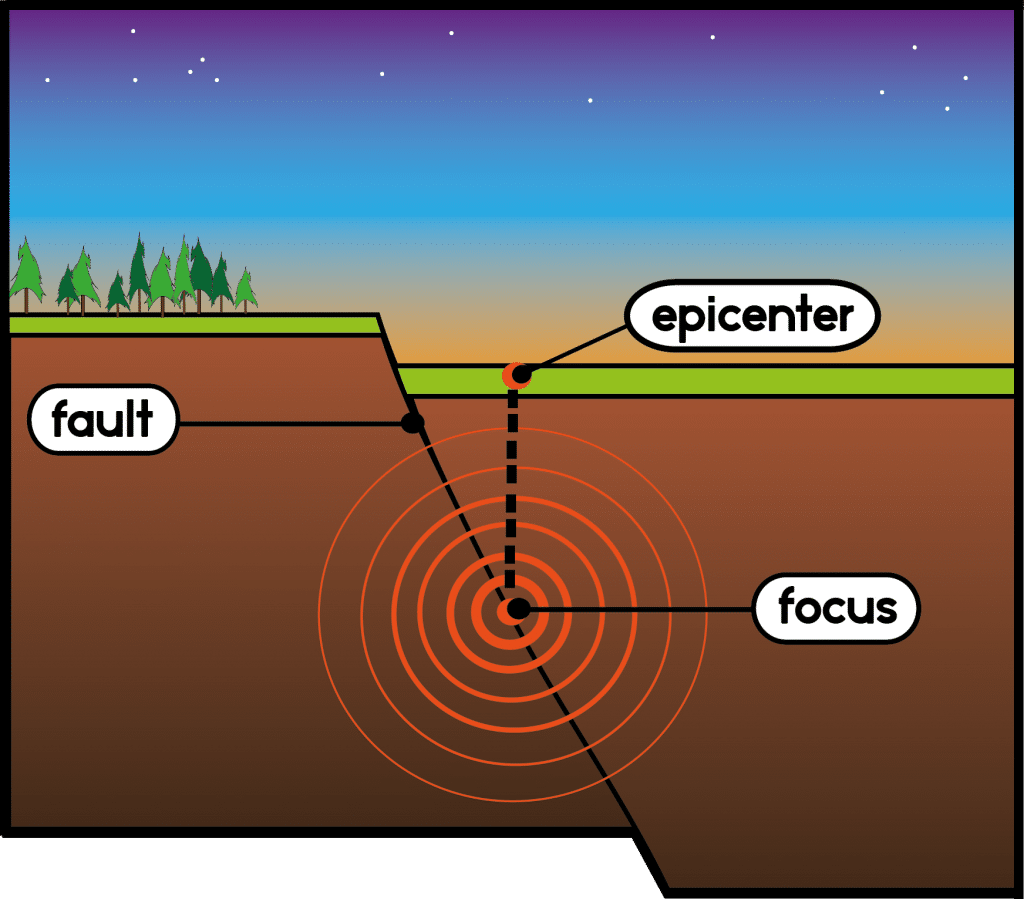Section 2: Earthquakes
An earthquake is the strongest natural force on Earth, and it is nearly impossible to predict and prevent. An earthquake is a vibration in the ground that results from the movement along faults or breaks in the Earth’s crust, where surfaces move past each other. In 1906, a massive earthquake hit San Francisco and devasted the area. Almost 30,000 buildings collapsed or were destroyed by fires. As a result, geologists knew they needed to understand more about earthquakes to help predict them in the future.

![]() Earth’s surface is made of tectonic plates that are constantly in motion. Where these plates meet is called a fault. Most faults occur along plate boundaries where the forces are so strong that Earth’s crust breaks. The most widely known fault is the San Andreas Fault, which runs vertically through California and is about 600 miles long. There are three main types of faults. The first is a normal fault, which forms when forces pull rocks apart along a divergent plate boundary. As a result, the block of rock above the fault moves down. The second fault is called a reverse fault, which forms when a force pushes two blocks of rock together with the rock above the fault moving up. The final fault is a strike-slip fault, where two blocks of rock slide horizontally past each other in opposite directions.
Earth’s surface is made of tectonic plates that are constantly in motion. Where these plates meet is called a fault. Most faults occur along plate boundaries where the forces are so strong that Earth’s crust breaks. The most widely known fault is the San Andreas Fault, which runs vertically through California and is about 600 miles long. There are three main types of faults. The first is a normal fault, which forms when forces pull rocks apart along a divergent plate boundary. As a result, the block of rock above the fault moves down. The second fault is called a reverse fault, which forms when a force pushes two blocks of rock together with the rock above the fault moving up. The final fault is a strike-slip fault, where two blocks of rock slide horizontally past each other in opposite directions.
 Earthquakes carry a tremendous amount of energy. When describing an earthquake, geologists look at the focus and epicenter. The focus is the point beneath Earth’s surface where rock under stress breaks to cause an earthquake. If an earthquake’s focus is shallow, it can cause the most damage because it’s closest to the surface where people live. The epicenter is the point on the surface directly above the focus. If you live near the epicenter of an earthquake, your location will most likely be affected.
Earthquakes carry a tremendous amount of energy. When describing an earthquake, geologists look at the focus and epicenter. The focus is the point beneath Earth’s surface where rock under stress breaks to cause an earthquake. If an earthquake’s focus is shallow, it can cause the most damage because it’s closest to the surface where people live. The epicenter is the point on the surface directly above the focus. If you live near the epicenter of an earthquake, your location will most likely be affected.

Earthquake schematic showing an earth cross-section and a seismograph.
Scientists study faults in order to predict how an earthquake may occur in the future. First, they look at seismic waves, which carry the energy of an earthquake away from the focus. There are three types of waves. Primary waves, or P waves, are compression waves that travel through solids and liquids. They compress and expand the material they pass through, which temporarily changes the volume. Secondary waves, or S waves, only travel through solids, temporarily changing the shape, not the volume of the material they pass through. They move slower than P waves. Finally, surface waves move slower than both P and S waves, but they can produce severe ground movement with a wavelike motion.
Locating an earthquake’s epicenter uses triangulating data from at least three seismometers or devices that measure and record ground motion. They help determine the distance seismic waves travel. To locate the epicenter, first find the arrival time difference between the first P wave and S wave, called lag time. Secondly, find the distance to the epicenter using a lag time vs. distance graph, and then go from the y-axis and read down to the x-axis. Finally, locate the epicenter using a map scale to mark the radius on a compass. Then draw a circle around each seismometer location to find the intersecting point.
Review:
- How does an earthquake occur?
- Compare a normal fault to a reverse fault.
- Explain the difference between a P wave and an S wave.
